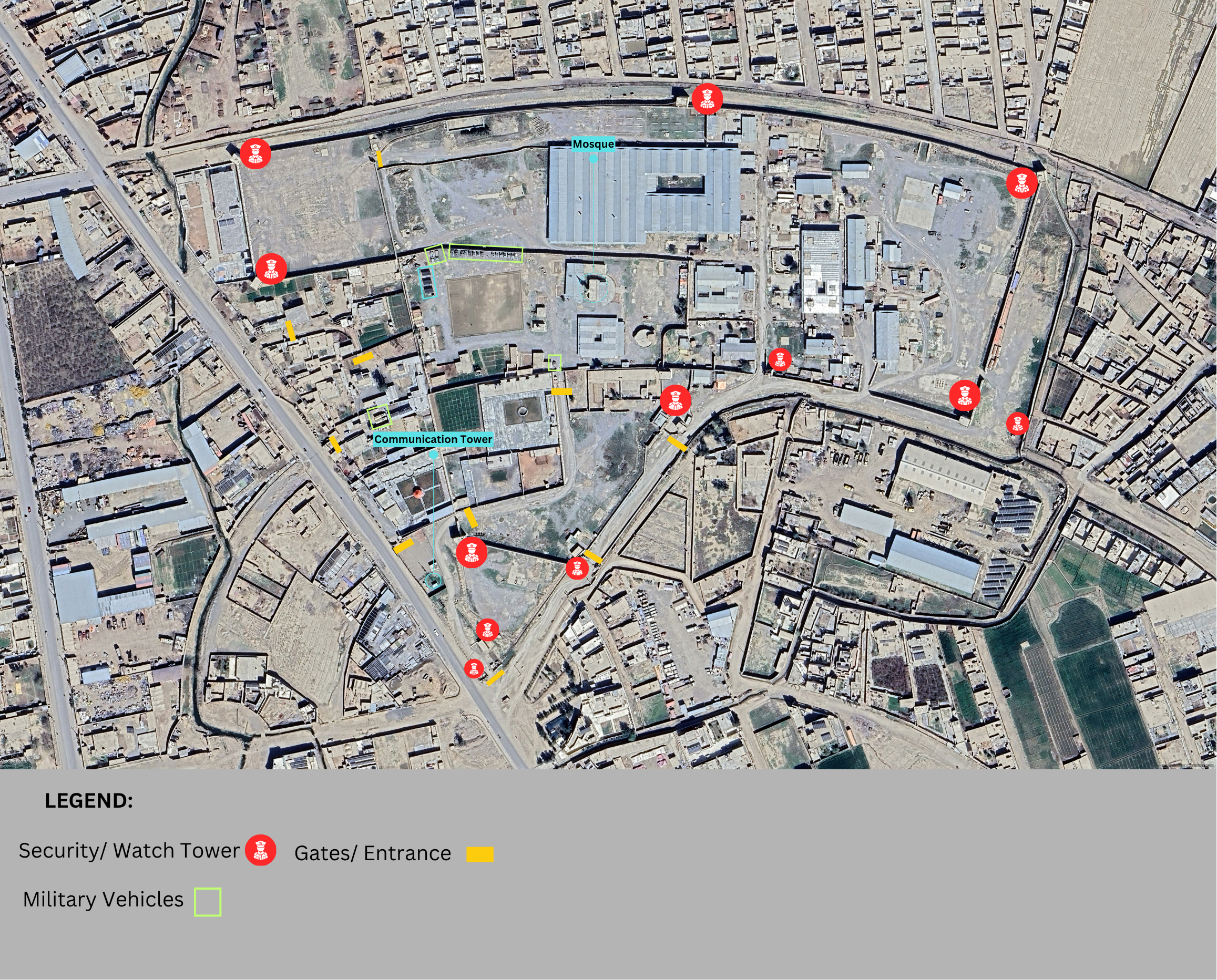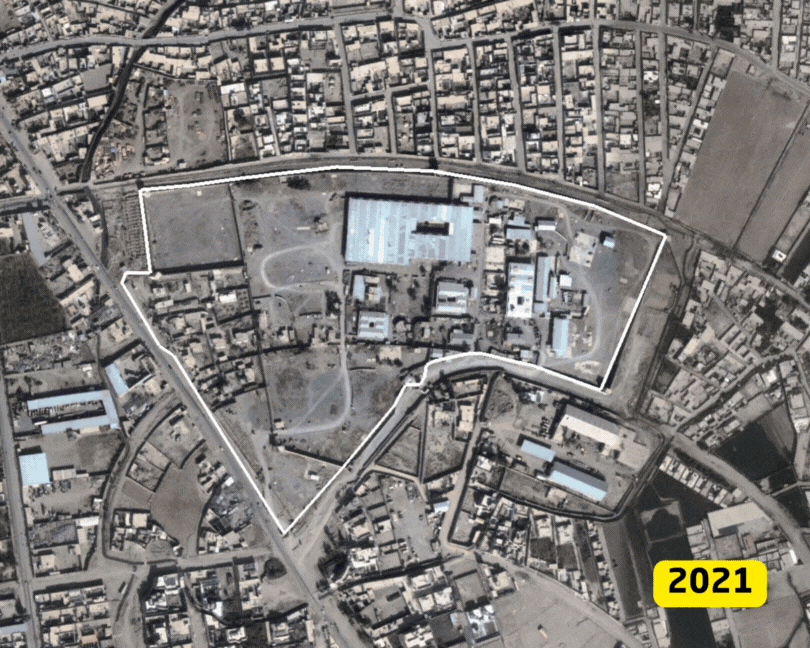OSINT reveals Taliban Supreme Leader’s location
An open-source investigation into the compounds, movements, and security apparatus surrounding the Taliban’s Supreme Leader in Kandahar.
Following the Taliban’s takeover of Afghanistan in August 2021, two figures have remained central to the group’s leadership: Sirajuddin Haqqani and the Taliban’s Supreme Leader, Hibatullah Akhundzada. While Haqqani, once known for concealing his identity, has since early 2022 appeared in public, Akhundzada continues to remain out of sight. He has never been photographed or filmed at public gatherings, maintaining a level of secrecy that extends far beyond standard security measures.
Intel Focus conducted an open-source investigation into recent developments surrounding the Taliban’s leadership infrastructure in Kandahar, the group’s traditional power base. The investigation aimed to identify physical and structural changes to key compounds, security facilities, and movement patterns across major districts of Kandahar city.
After geolocating the residence of Sirajuddin Haqqani in his home province of Paktia, Intel Focus identified four locations in Kandahar that appear to accommodate senior Taliban officials, including their supreme leader or serve as venues for high-level meetings. These compounds are reportedly used when Akhundzada summons senior members of the movement to Kandahar. The investigator also verified the primary compound allegedly frequented by the Supreme Leader, where Afghan-American national Mahmood Shah Habibi is believed to be held.
Since mid-September 2024, Kandahar has witnessed a notable tightening of security measures following reports that the International Criminal Court had issued arrest warrants in connection with human rights violations, particularly the persecution of women and girls. In response, the Taliban reportedly strengthened Akhundzada’s protection, establishing a specialised unit known as Amir-ul Momineen Khas Zwak (Special Force of the Supreme Leader). This unit, commanded by Mawlawi Abdul Ahad Talib. Mawlawi Taliban was appointed as Kandahar’s chief of police in February 2025 and remains a close confidante of the Taliban’s Supreme Leader.
Figure: A Toyota Landcruiser Pickup Truck with an anti-air gun mounted on drives through Kandahar belonging to Khas Zwak (Special Force) of the Taliban’s Supreme Leader. Source: X
After analysing the publicly available visuals and videos of the Khas Zwak, the unit is believed to operate a convoy of around 16 to 20 vehicles, including Toyota Hilux and Toyota Land Cruiser pickup trucks. Each vehicle is typically manned by approximately seven personnel, with at least one vehicle equipped with an anti-aircraft gun and others armed with rocket launchers or mounted machine guns. The total force is estimated at 100-140 personnel, most armed with U.S.-origin M4 carbine rifles. The unit also operates roughly ten motorcycles, likely used for rapid movement and local reconnaissance within urban areas.
Figure: The convoy of Khas Zwak (Special Force) of the Taliban’s Supreme Leader during a parade east of Kandahar city. Source: X
Drawing on the analysis of open-source data, including local media, Taliban-affiliated channels, and satellite imagery, Intel Focus identified four key locations in Kandahar that appear to serve as the Supreme Leader’s potential residences, meeting sites, or secure compounds.
The Mandigak Palace
This site is believed to host nearly all key meetings between the Taliban’s Supreme Leader and senior-ranking officials. During the group’s first period in power in the 90s, Mullah Mohammad Omar, the Taliban’s founder, resided and maintained his office within the Mandigak Palace. According to recent reports, security measures around the palace were significantly reinforced earlier this year.
Figure: The Mandigak Palace with the lastest satellite imagery available on Google Earth Pro.
The Mandigak Palace, spanning an estimated 50,000 square metres, is reportedly the primary compound frequented by the Taliban’s Supreme Leader, Hibatullah Akhundzada. The site is located at coordinates 31.614730, 65.690386 in Kandahar city. In the visual above, guard icons indicate the positions of security personnel and access points, while the main assembly hall is marked in red. (See figure above)
The “Unknown Compound”
One of the locations that underwent notable structural changes after 2021 is referred to in this investigation as the “Unknown Compound”. The name reflects the absence of any identifiable references to this site in open-source data.
At first glance, the compound appears residential; however, satellite imagery reveals multiple guarded entrances, security towers, a mosque, a communications tower, several cultivated plots, and a number of military vehicles, including US-made Humvees, stationed within the perimeter.
Figure: Image showing the “Unknown Compound” surrounded by industrial and residential areas. Geolocation: 31.630477, 65.734954
Covering an estimated 140,000 square metres, the compound lies to the northeast of Kandahar city and west of Aino Mina. Its layout suggests a fortified, self-sufficient facility, with agricultural areas likely supporting sustained occupancy. Several buildings resemble typical residential structures, indicating that the Taliban’s leadership may maintain elements of daily life within a heavily secured environment. Many of the structures and changes are visible after 2021, the year the Taliban came back to power. (See figure above & below.)
Figure: The ‘‘Unknown Compound’’ appears to witness changes after 2021.
Attal Palace in Aino Mina
Afghan media outlets have reported that Taliban leader Hibatullah Akhundzada maintains a guesthouse in Aino Mina, a modern township located northeast of Kandahar city. The property, referred to as Attal Palace, was reportedly used by the late General Abdul Raziq Achakzai, Kandahar’s former police chief, prior to his assassination in 2018.
Intel Focus conducted a contextual geospatial analysis to identify the possible location of this guesthouse within Aino Mina. Due to the absence of publicly available imagery of the building, the investigation relied on manual comparison of satellite imagery and open-source mapping data across multiple timeframes. Structural and environmental changes were examined street by street to detect restricted areas or signs of heightened security activity.
Figure: Anlaysis of the Attal Palace, guesthouse frequented by the Taliban’s supreme leader. Geolocation: 31.623271, 65.775213
The analysis identified a residential block displaying characteristics consistent with a high-security compound, including visible road barriers, restricted access points, and checkpoint structures. These indicators align with reports suggesting that the guesthouse continues to serve as a secure site associated with the Taliban’s leadership network.
Satellite imagery from March 2025 indicates further barriers leading to the block compared to the imagery from 2023. The satellite imagery from 2021 shows no road barriers or significant security objects near or around this block.
According to reports, Mahmood Shah Habibi, an Afghan-American citizen, is currently being held at this location (31.623271, 65.775213), allegedly, by the Taliban. The FBI reported him as a ‘missing person’ since August 2022. Despite the evidence, the Taliban denied claims that they detained Habibi.
Figure: Geolocation of a video from inside the courtyard of a guesthouse frequented by senior Taliban and their supreme leader, northeast of Kandahar city. Geolocation: 31.623271, 65.775213
In January 2024, a video was shared by Afghanistan International news outlet on X, reportedly claiming to show the guesthouse of General Raziq, which has been taken over by the Taliban’s supreme leader, citing General Raziq’s brother, Tadin Khan. Intel Focus has been able to geolocate this video and match it to the building identified in Aino Mina. (See above figure)
Kandahar Governor’s Office
The Kandahar Governor’s Office is located in the centre of Kandahar city and has long been a focal point of political and security activity. In 2012, two Taliban members reportedly evaded an American-operated security checkpoint at the site, concealing pistols in their shoes before attempting to assassinate the then-provincial governor during the former Afghan Republic.
The location also holds historical significance: it was here that Kandahar’s former police chief, General Abdul Raziq Achakzai, a prominent anti-Taliban figure, was assassinated by a gunman during a meeting with US General Scott Miller on 18 October 2018.
Figure: Image showing the governor’s office in Kandahar in 2025. Geolocation: 31.619045, 65.709748
Under Taliban control, the compound has since been heavily fortified and remains one of the most secure administrative buildings in the city. Open-source reporting indicates that the site is occasionally visited by Hibatullah Akhundzada, the Taliban’s Supreme Leader, though such visits appear infrequent.
While these compounds appear to serve as the primary locations associated with the movements and activities of Hibatullah Akhundzada, it is highly likely given his role and authority within the Taliban’s hierarchy that he spends extended periods across some or all of these sites. However, in the absence of ground-level intelligence or human informant reporting, it is not currently possible to verify the timing or duration of his presence at any specific compound. The possibility that the Taliban’s Supreme Leader alternates between these secure sites, or retreats to underground facilities in response to perceived threats or credible targeting intelligence, cannot be ruled out.
Intel Focus independently carried out this investigation using open-source data, satellite imagery, and contextual analysis.
Investigator: Qais Alamdar
For further inquiries, contact us: info@intelfocus.org









